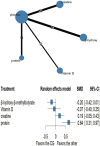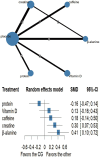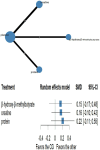Effects of different dietary supplements combined with conditioning training on muscle strength, jump performance, sprint speed, and muscle mass in athletes: a systematic review and network meta-analysis
- PMID: 40717998
- PMCID: PMC12295849
- DOI: 10.3389/fnut.2025.1636970
Effects of different dietary supplements combined with conditioning training on muscle strength, jump performance, sprint speed, and muscle mass in athletes: a systematic review and network meta-analysis
Abstract
Background: As dietary supplements have become integral to meeting athletes' specialised nutritional requirements, research into their effects on performance has intensified. Yet inconsistent findings leave the efficacy of some supplements-most notably branched-chain amino acids and β-hydroxy-β-methylbutyrate (HMB)-open to debate. To clarify which products offer the greatest benefit, we undertook a systematic review and network meta-analysis aimed at identifying the supplements most effective for athletes, including protein, creatine, β-alanine, HMB, vitamin D, caffeine, and others.
Methods: PubMed, Web of Science, the Cochrane Library, Embase and SPORTDiscus were searched from database inception to 15 March 2024 for RCTs evaluating the effects of dietary supplements (including but not limited to protein, creatine, β-alanine, HMB, caffeine, and vitamin D) on athletic performance. Risk of bias was appraised with the revised Cochrane RoB 2 tool. A network meta-analysis was performed in R.
Results: We included 35 randomized controlled trials comprising 991 athletes who completed strength and conditioning training in conjunction with various dietary supplements or a placebo. The risk of bias assessment indicated that 8.57% of studies were at low risk, 88.57% had some concerns, and 2.86% were at high risk of bias. Protein supplementation yielded the greatest improvement in muscular strength (standardized mean difference [SMD] = 0.64, 95% confidence interval [CI] 0.31-0.97; surface under the cumulative ranking curve [SUCRA] = 99.6%; very low-certainty evidence). Both β-alanine (SMD = 0.41, 95% CI 0.10-0.72; SUCRA = 89.0%; moderate-certainty evidence) and creatine (SMD = 0.30, 95% CI 0.07-0.53; SUCRA = 76.06%; moderate-certainty evidence) significantly enhanced jump performance, with β-alanine ranking marginally higher. Creatine also reduced sprint time (SMD = -0.42, 95% CI - 0.68 to -0.16; SUCRA = 94.57%; moderate-certainty evidence). No supplement significantly increased lean body mass.
Conclusion: Protein supplementation appears to be the most effective strategy for increasing muscular strength; β-alanine and creatine both improve jump performance, with β-alanine offering marginally superior effectiveness; and creatine is particularly beneficial for sprint speed. As none of the supplements meaningfully increased muscle mass, practitioners should align supplementation strategies with the targeted performance attribute and training phase to optimise the synergy between nutrition and training and maximise athletic outcomes.
Systematic review registration: PROSPERO, CRD420251048402.
Keywords: ergogenic aids; sport nutrition; sport performance; sportsman; supplementation.
Copyright © 2025 Deng, Yan, He, Lin, Liu, Chen, He and Li.
Conflict of interest statement
The authors declare that the research was conducted in the absence of any commercial or financial relationships that could be construed as a potential conflict of interest.
Figures







Similar articles
-
Systemic pharmacological treatments for chronic plaque psoriasis: a network meta-analysis.Cochrane Database Syst Rev. 2017 Dec 22;12(12):CD011535. doi: 10.1002/14651858.CD011535.pub2. Cochrane Database Syst Rev. 2017. Update in: Cochrane Database Syst Rev. 2020 Jan 9;1:CD011535. doi: 10.1002/14651858.CD011535.pub3. PMID: 29271481 Free PMC article. Updated.
-
Systemic pharmacological treatments for chronic plaque psoriasis: a network meta-analysis.Cochrane Database Syst Rev. 2020 Jan 9;1(1):CD011535. doi: 10.1002/14651858.CD011535.pub3. Cochrane Database Syst Rev. 2020. Update in: Cochrane Database Syst Rev. 2021 Apr 19;4:CD011535. doi: 10.1002/14651858.CD011535.pub4. PMID: 31917873 Free PMC article. Updated.
-
Systemic pharmacological treatments for chronic plaque psoriasis: a network meta-analysis.Cochrane Database Syst Rev. 2021 Apr 19;4(4):CD011535. doi: 10.1002/14651858.CD011535.pub4. Cochrane Database Syst Rev. 2021. Update in: Cochrane Database Syst Rev. 2022 May 23;5:CD011535. doi: 10.1002/14651858.CD011535.pub5. PMID: 33871055 Free PMC article. Updated.
-
Effects of different dietary supplements on athletic performance in soccer players: a systematic review and network meta-analysis.J Int Soc Sports Nutr. 2025 Dec;22(1):2467890. doi: 10.1080/15502783.2025.2467890. Epub 2025 Feb 19. J Int Soc Sports Nutr. 2025. PMID: 39972597 Free PMC article.
-
Advantages of different dietary supplements for elite combat sports athletes: a systematic review and Bayesian network meta-analysis.Sci Rep. 2025 Jan 2;15(1):271. doi: 10.1038/s41598-024-84359-3. Sci Rep. 2025. PMID: 39747536 Free PMC article.
References
-
- Collins J, Maughan RJ, Gleeson M, Bilsborough J, Jeukendrup A, Morton JP, et al. UEFA expert group statement on nutrition in elite football. Current evidence to inform practical recommendations and guide future research. Br J Sports Med. (2021) 55:416–6. doi: 10.1136/bjsports-2019-101961, PMID: - DOI - PubMed
-
- Zhou HH, Liao Y, Zhou X, Peng Z, Xu S, Shi S, et al. Effects of timing and types of protein supplementation on improving muscle mass, strength, and physical performance in adults undergoing resistance training: a network meta-analysis. Int J Sport Nutr Exerc Metab. (2024) 34:54–64. doi: 10.1123/ijsnem.2023-0118, PMID: - DOI - PubMed
Publication types
LinkOut - more resources
Full Text Sources
Research Materials

